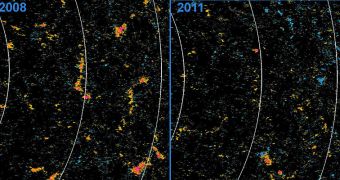In two papers to appear in print soon, astronomers and solar physicists provide more details about how the Sun reverses its magnetic fields, swapping its north and south magnetic fields between them. The studies also provide detailed maps of solar magnetic field asymmetries that accompany the process.
Our parent star reverses its magnetic field once ever 11 years, a period known as the solar cycle. Throughout this period, individual magnetic fields dance across its surface in a complex ballet, which scientists have yet to understand fully.
But several space missions are in orbit today, with the precise purpose of figuring out how these fields interact. Learning more about this could help experts predict when the Sun will enter its period of heightened activity, called the solar maximum.
While the reversal occurs precisely once every 11 years, the two new papers suggest that the process is very asymmetrical. The documents show that the north pole of the Sun is currently displaying a polarity close to zero, whereas the polarity of the south pole has just begun to decrease.
“Right now, there's an imbalance between the north and the south poles. The north is already in transition, well ahead of the south pole, and we don't understand why,” expert Jonathan Cirtain says.
He holds an appointment as a space scientist at the NASA Marshall Space Flight Center (MSFC), in Huntsville, Alabama, and is also a NASA project scientist for a Japanese solar mission Hinode.
The two new studies were carried out using Hinode, the Nobeyama Solar Radio Observatory telescopes and the ESA/NASA Solar Heliospheric Observatory (SOHO). Both papers indicate that the polarity of the solar poles does not change simultaneously, as previously thought.
Studying the solar poles is difficult because most of the observatories trained at the Sun see it from above the Equator. This position only provides an oblique view of the poles. In order to conduct the most accurate measurements, these spacecraft should be in a polar orbit around the star.
The papers also suggest that solar physicists may have to refine or rethink some of the existing models explaining how the Sun operates. The documents indicate that we may not have such a good understanding of the star as we first thought.
Finding out more about how the Sun functions could, in turn, provide us with a means of understanding how other stars evolve over time as well.

 14 DAY TRIAL //
14 DAY TRIAL //